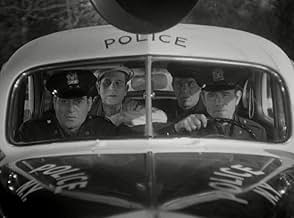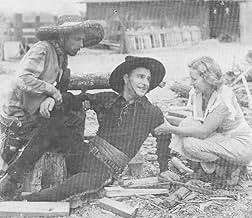Buddy Roosevelt(1898-1973)
- Actor
- Stunts
- Additional Crew
Cowboy actor Buddy Roosevelt was born Kenneth Stanhope Sanderson in Meeker, Colorado, in 1898. His parents were emigrants from England, and at age 16 Kenneth got a job with the C.B. Irwin WIld West Show. When the show traveled to Southern California in 1914, the young Sanderson learned that stunt work in the burgeoning film industry paid much better, and was quite a bit safer, than busting broncs and the kind of roping, trick riding and other hard and dangerous tasks required of a Wild West show performer, and he soon got a job doing stunts in westerns for pioneering producerThomas H. Inceat his Inceville studio, and often performed as a stunt double forWilliam S. Hart.When the US entered World War I in 1917 Roosevelt enlisted in the Navy and was aboard the USS Norfolk when it was sunk. As if that wasn't enough, he contracted the Spanish flu during the 1918 influenza pandemic that killed millions worldwide, but he managed to survive both the sinking and the flu and returned to Hollywood at war's end.
Going back to stunt work, he was the stunt double for matinee idolRudolph ValentinoinThe Sheik (1921),the picture that made Valentino a star. After more stunt work and small parts in a few films, Sanderson was hired by shoestring producerLester F. Scott Jr.to star in a series of low-budget westerns. Scott didn't think that "Kenneth Sanderson" was enough of a cowboy name so he changed it to Buddy Roosevelt. The newly renamed cowboy actor madeRough Ridin' (1924)for Scott, the first of 25 that Roosevelt would make for him. Budgets for these pictures were usually less than $25,000--a paltry sum even for the early 1920s--but Scott had the sense to hire veteran supporting characters and efficient directors like a youngRichard Thorpe(later to become a mainstay at prestigious MGM) and the pictures proved popular and made money. Unfortunately for Roosevelt, however, Scott signed two more cowboy actors,Jay WilseyandHal Taliaferro,which meant that the low budgets on Roosevelt's films got even lower.
In 1928 Roosevelt left Scott for another "B" outfit, Rayart Pictures, but the films he made for that company weren't much of an improvement over his Scott opuses (and in many cases were even worse). After a half-dozen of Rayart's "extravaganzas", Roosevelt managed to get a good role in a big picture for a major studio--The Cisco Kid inIn Old Arizona (1928)for Fox. As luck would have it, though, Roosevelt broke his leg shortly before filming was to start. He was replaced byWarner Baxter,who went on to win an Academy Award for the part, which started him on a long and distinguished career. Buddy, on the other hand, went back to making "B" (and even lower-grade) horse operas. He signed with cheapjack producer/directorJack Irwinfor a trio of oaters that were barely released. Irwin ran out of money on the third of this trio, "Valley of Bad Men" --which was apparently NEVER released--and Roosevelt was once again out of a job. He did some stunt work and got some small parts in small films, and eventually signed with low-rent specialistVictor Adamson(aka Denver Dixon) for a series of extremely low-budget westerns for Adamson's Superior Talking Pictures outfit. Supposedly shot in only a few days on budgets that were so low that Superior could only afford to pay Roosevelt $250 for each one, these films have gained a reputation for incoherence, ineptness and cheapness that few others have achieved, even to this day.
These pictures finished Buddy Roosevelt's career as a "star", but he still remained active in the business, doing stunt work and appearing in small parts and bit roles until he retired after making his last film,The Man Who Shot Liberty Valance (1962),in 1962. He died in his home town of Meeker, Colorado, on October 6, 1973.
Going back to stunt work, he was the stunt double for matinee idolRudolph ValentinoinThe Sheik (1921),the picture that made Valentino a star. After more stunt work and small parts in a few films, Sanderson was hired by shoestring producerLester F. Scott Jr.to star in a series of low-budget westerns. Scott didn't think that "Kenneth Sanderson" was enough of a cowboy name so he changed it to Buddy Roosevelt. The newly renamed cowboy actor madeRough Ridin' (1924)for Scott, the first of 25 that Roosevelt would make for him. Budgets for these pictures were usually less than $25,000--a paltry sum even for the early 1920s--but Scott had the sense to hire veteran supporting characters and efficient directors like a youngRichard Thorpe(later to become a mainstay at prestigious MGM) and the pictures proved popular and made money. Unfortunately for Roosevelt, however, Scott signed two more cowboy actors,Jay WilseyandHal Taliaferro,which meant that the low budgets on Roosevelt's films got even lower.
In 1928 Roosevelt left Scott for another "B" outfit, Rayart Pictures, but the films he made for that company weren't much of an improvement over his Scott opuses (and in many cases were even worse). After a half-dozen of Rayart's "extravaganzas", Roosevelt managed to get a good role in a big picture for a major studio--The Cisco Kid inIn Old Arizona (1928)for Fox. As luck would have it, though, Roosevelt broke his leg shortly before filming was to start. He was replaced byWarner Baxter,who went on to win an Academy Award for the part, which started him on a long and distinguished career. Buddy, on the other hand, went back to making "B" (and even lower-grade) horse operas. He signed with cheapjack producer/directorJack Irwinfor a trio of oaters that were barely released. Irwin ran out of money on the third of this trio, "Valley of Bad Men" --which was apparently NEVER released--and Roosevelt was once again out of a job. He did some stunt work and got some small parts in small films, and eventually signed with low-rent specialistVictor Adamson(aka Denver Dixon) for a series of extremely low-budget westerns for Adamson's Superior Talking Pictures outfit. Supposedly shot in only a few days on budgets that were so low that Superior could only afford to pay Roosevelt $250 for each one, these films have gained a reputation for incoherence, ineptness and cheapness that few others have achieved, even to this day.
These pictures finished Buddy Roosevelt's career as a "star", but he still remained active in the business, doing stunt work and appearing in small parts and bit roles until he retired after making his last film,The Man Who Shot Liberty Valance (1962),in 1962. He died in his home town of Meeker, Colorado, on October 6, 1973.



































